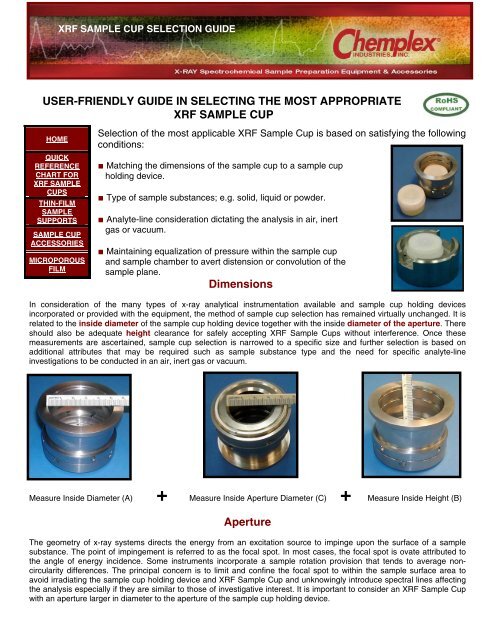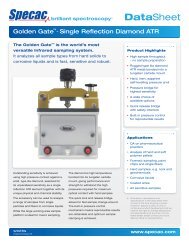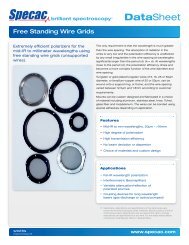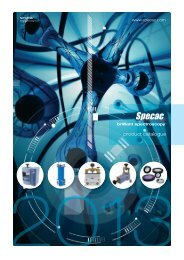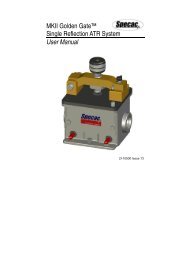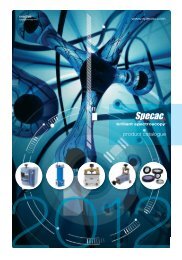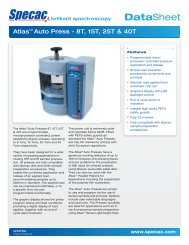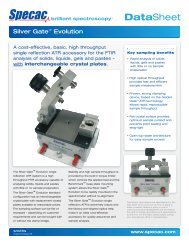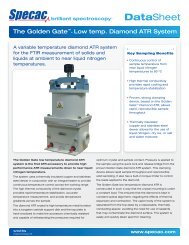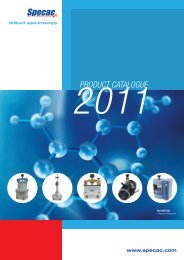Chemplex Industries XRF Consumables Catalogue - Specac
Chemplex Industries XRF Consumables Catalogue - Specac
Chemplex Industries XRF Consumables Catalogue - Specac
Create successful ePaper yourself
Turn your PDF publications into a flip-book with our unique Google optimized e-Paper software.
<strong>XRF</strong> SAMPLE CUP SELECTION GUIDE<br />
USER-FRIENDLY GUIDE IN SELECTING THE MOST APPROPRIATE<br />
<strong>XRF</strong> SAMPLE CUP<br />
HOME<br />
QUICK<br />
REFERENCE<br />
CHART FOR<br />
<strong>XRF</strong> SAMPLE<br />
CUPS<br />
THIN-FILM<br />
SAMPLE<br />
SUPPORTS<br />
SAMPLE CUP<br />
ACCESSORIES<br />
MICROPOROUS<br />
FILM<br />
Selection of the most applicable <strong>XRF</strong> Sample Cup is based on satisfying the following<br />
conditions:<br />
■ Matching the dimensions of the sample cup to a sample cup<br />
holding device.<br />
■ Type of sample substances; e.g. solid, liquid or powder.<br />
■ Analyte-line consideration dictating the analysis in air, inert<br />
gas or vacuum.<br />
■ Maintaining equalization of pressure within the sample cup<br />
and sample chamber to avert distension or convolution of the<br />
sample plane.<br />
Dimensions<br />
In consideration of the many types of x-ray analytical instrumentation available and sample cup holding devices<br />
incorporated or provided with the equipment, the method of sample cup selection has remained virtually unchanged. It is<br />
related to the inside diameter of the sample cup holding device together with the inside diameter of the aperture. There<br />
should also be adequate height clearance for safely accepting <strong>XRF</strong> Sample Cups without interference. Once these<br />
measurements are ascertained, sample cup selection is narrowed to a specific size and further selection is based on<br />
additional attributes that may be required such as sample substance type and the need for specific analyte-line<br />
investigations to be conducted in an air, inert gas or vacuum.<br />
Measure Inside Diameter (A) + Measure Inside Aperture Diameter (C) + Measure Inside Height (B)<br />
Aperture<br />
The geometry of x-ray systems directs the energy from an excitation source to impinge upon the surface of a sample<br />
substance. The point of impingement is referred to as the focal spot. In most cases, the focal spot is ovate attributed to<br />
the angle of energy incidence. Some instruments incorporate a sample rotation provision that tends to average noncircularity<br />
differences. The principal concern is to limit and confine the focal spot to within the sample surface area to<br />
avoid irradiating the sample cup holding device and <strong>XRF</strong> Sample Cup and unknowingly introduce spectral lines affecting<br />
the analysis especially if they are similar to those of investigative interest. It is important to consider an <strong>XRF</strong> Sample Cup<br />
with an aperture larger in diameter to the aperture of the sample cup holding device.


